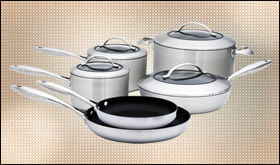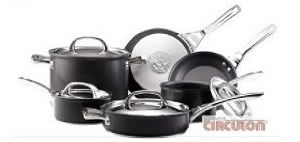The nonstick cookware set is popular because it is easy to use. Health matters aside, nonstick cookware is a consideration for everyday cooks who want food to slide off the cookware followed by an easy cleanup. Even when using stainless steel skillets to get that great fond for sauces, experienced cooks will use nonstick cookware for delicate meals like fish and eggs.
What is the actual cookware material?
The quality of cookware is not determined as much by the external or internal coating, as it is by the main cookware material itself. Too many shoppers looking for ease of use will get nonstick cookware without any regard for the more important core material. Today, nonstick surfaces are being applied to anodized aluminum, stainless steel, copper, and other materials. A quality piece of cookware will have aluminum or copper clad inside the cookware.
What should I get in a nonstick cookware set?

Here is an example of what you should get in a quality nonstick cookware set. This one, at the time of this writing, is the Scanpan CTX 10 piece nonstick cookware set. Please note that this is a premier nonstick cookware set, chef grade, that is eco-friendly and considered healthy. One can use high heat and metal utensils on Scanpan CTX cookware.
- 2 quart sauce pan w/ lid
- 2 3/4 quart sauce pan w/ lid
- 10 1/2 inch saute pan w/ lid
- 7 1/2 quart stockpot w/ lid
- 10 1/4 inch skillet
- 8 inch skillet
- 5-Layer clad recycled aluminum-stainless steel construction
- Suitable for all stove tops including induction
Quality Nonstick Coating
Several manufacturers claim to have the “toughest” nonstick surface. DuPont, the maker of Teflon, has the Autograph 2 nonstick coating as their top of the line product. It is found on a number of quality cookware products including Anolon. T-Fal is known to be very tough. Circulon advertises their Total line to outlast all other nonstick surfaces. If you are going to go with nonstick, stick with a high quality manufacturer.
Heating and cleaning nonstick cookware

As with most nonstick surfaces, use low to medium heat. Higher heat can not only damage the cookware itself and the coating, but also possibly release harmful fumes. Read the care and use instructions of the cookware. If it claims to be dishwasher safe, is it safe all the time, or just some of the time. Most nonstick surfaces have instructions to clean by hand.
As seen in our exclusive article on Matching Cookware to the Cook, nonstick surfaces are suitable for the Reluctant Cook and the Busy Cook. These surfaces are attractive for frying foods up without sticking and an easy cleanup. There are good deals out there, but be sure you get a quality set made of quality cookware materials. One quality material to consider is stainless steel clad with aluminum inside. Check out our article on A Powerful Blend – Stainless Nonstick.
Happy Cooking!

